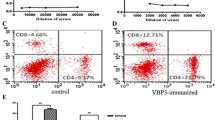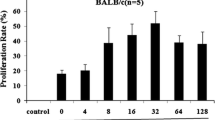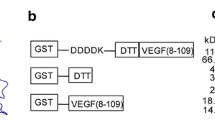Abstract
Although the critical role of complement component C3d as a molecular adjuvant in preventing virus infection is well established, its role in cancer prophylaxis and treatment is unclear. In this study, we constructed a recombinant plasmid encoding Flk-1 and C3d3 fusion proteins and investigated its transient expression in vitro in transfected eukaryotic cells and its antibody response in immunized mice. Subsequently, we investigated the vaccine’s ability to elicit an immune response leading to suppression of angiogenesis and tumor growth in mice bearing bladder transitional cell carcinoma. Using Western blotting, immunocytochemistry, and flow cytometry, we detected the expression of Flk-1 and C3d3 fusion proteins in COS-7 cells transfected with these recombinant plasmids. Further binding experiment using CR2 (C3d receptor) positive Raji cells that were incubated with transfected COS-7 supernatant indicated that C3d was successfully fused to Flk-1. Although both vaccines elicited peak antibody levels at 5 weeks, Flk-1-specific antibody titer in pSG.SS.Flk-1ECD.C3d3.YL-immunized mice was significantly higher when compared to pSG.SS.Flk-1ECD.YL-immunized mice. The results of experiments with bladder tumor-bearing mice showed that the vaccine inhibited tumor growth significantly. These results suggest that C3d plays a critical role in tumor immunotherapy by promoting antibody response in Flk-1-based DNA vaccines. This approach may provide a new strategy for the rational design of anti-angiogenic therapies for the treatment of solid tumors and provide a basis for the further exploitation and application of the anti-angiogenesis DNA vaccines.







Similar content being viewed by others
References
Folkman J (1971) Tumor angiogenesis: therapeutic implication. N Engl J Med 285:1182–1186
Bhat TA, Singh RP (2008) Tumor angiogenesis-A potential target in cancer chemoprevention. Food Chem Toxicol 46:1334–1345
Bamias A, Dimopoulos MA (2003) Angiogenesis in human cancer: implications in cancer therapy. Eur J Intern Med 14:459–469
Koehl GE, Wagner F, Stoeltzing O et al (2007) Mycophenolate mofetil inhibits tumor growth and angiogenesis in vitro but has variable antitumor effects in vivo, possibly related to bioavailability. Transplantation 83:607–614
Niethammer AG, Xiang R, Becker JC et al (2002) A DNA vaccine against VEGF receptor 2 prevents effective angiogenesis and inhibits tumor growth. Nat Med 8:1369–1375
Rad FH, Le Buanec H, Paturance S et al (2007) VEGF kinoid vaccine, a therapeutic approach against tumor angiogenesis and metastases. Proc Natl Acad Sci USA 104:2837–2842
Reisfeld RA, Niethammer AG, Luo Y et al (2004) DNA vaccines designed to inhibit tumor growth by suppression of angiogenesis. Int Arch Allergy Immunol 133:295–304
Liu JY, Wei YQ, Yang L et al (2003) Immunotherapy of tumors with vaccine based on quail homologous vascular endothelial growth factor receptor-2. Blood 102:1815–1823
Boehm T, Folkman J, Browder T et al (1997) Antiangiogenic therapy of experimental cancer does not induce acquired drug resistance. Nature 390:404–407
Ferrara N (2002) VEGF and the quest for tumour angiogenesis factors. Nat Rev Cancer 2:795–803
Hou JM, Liu JY, Yang L et al (2005) Combination of low-dose gemcitabine and recombinant quail vascular endothelial growth factor receptor-2 as a vaccine induces synergistic antitumor activities. Oncology 69:81–87
Alessi P, Ebbinghaus C, Neri D (2004) Molecular targeting of angiogenesis. Biochim Biophys Acta 1654:39–49
Abdollahi A, Lipson KE, Han X et al (2003) SU5416 and SU6668 attenuate the angiogenic effects of radiation-induced tumor cell growth factor production and amplify the direct anti-endothelial action of radiation in vitro. Cancer Res 63:3755–3763
Singhal S, Vachani A, Antin-Ozerkis D et al (2005) Prognostic implications of cell cycle, apoptosis, and angiogenesis biomarkers in non-small cell lung cancer: a review. Clin Cancer Res 11:3974–3986
Dempsey PW, Allison ME, Akkaraju S et al (1996) C3d of complement as a molecular adjuvant: bridging innate and acquired immunity. Science 271:348–350
Wang L, Sunyer JO, Bello LJ (2004) Fusion to C3d enhances the immunogenicity of the E2 glycoprotein of type 2 bovine viral diarrhea virus. J Virol 78:1616–1622
Fan H, Tong T, Chen H et al (2007) Immunization of DNA vaccine encoding C3d-VP1 fusion enhanced protective immune response against foot-and-mouth disease virus. Virus Genes 35:347–357
Green TD, Newton BR, Rota PA et al (2001) C3d enhancement of neutralizing antibodies to measles hemagglutinin. Vaccine 20:242–248
Hannan JP, Young KA, Guthridge JM et al (2005) Mutational analysis of the complement receptor type 2 (CR2/CD21)-C3d interaction reveals a putative charged SCR1 binding site for C3d. J Mol Biol 346(3):845–858
Hess MW, Schwendinger MG, Eskelinen EL et al (2000) Tracing uptake of C3dg-conjugated antigen into B cells via complement receptor type 2 (CR2, CD21). Blood 95:2617–2623
Cherukuri A, Cheng PC, Pierce SK (2001) The role of the CD19/CD21 complex in B cell processing and presentation of complement-tagged antigens. J Immunol 167:163–167
Konozo Y, Abe R, Konozo H et al (1998) Cross-linking CD21/CD35 or CD19 increases both B7-1 and B7-2 expression on murine splenic B cell. J Immunol 160:1565–1572
Bower JF, Ross TM (2006) A minimum CR2 binding domain of C3d enhances immunity following vaccination. Adv Exp Med Biol 586:249–264
Jegou JF, Chan P, Schouft MT et al (2007) C3d binding to the myelin oligodendrocyte glycoprotein results in an exacerbated experimental autoimmune encephalomyelitis. J Immunol 178:3323–3331
Knopf PM, Rivera DS, Hai SH et al (2008) Novel function of complement C3d as an autologous helper T-cell target. Immunol Cell Biol 86:221–225
Acknowledgments
The authors wish to thank the study participants for their cooperation, which made this study possible. They are also grateful to the National Natural Science Foundation of China for its financial support (No. 30571864).
Conflict of interest statement
The authors have no financial conflicts of interest.
Author information
Authors and Affiliations
Corresponding author
Rights and permissions
About this article
Cite this article
Liang, Ph., Zhang, Kq., Xu, Gl. et al. Construction of a DNA vaccine encoding Flk-1 extracellular domain and C3d fusion gene and investigation of its suppressing effect on tumor growth. Cancer Immunol Immunother 59, 93–101 (2010). https://doi.org/10.1007/s00262-009-0727-2
Received:
Accepted:
Published:
Issue Date:
DOI: https://doi.org/10.1007/s00262-009-0727-2




